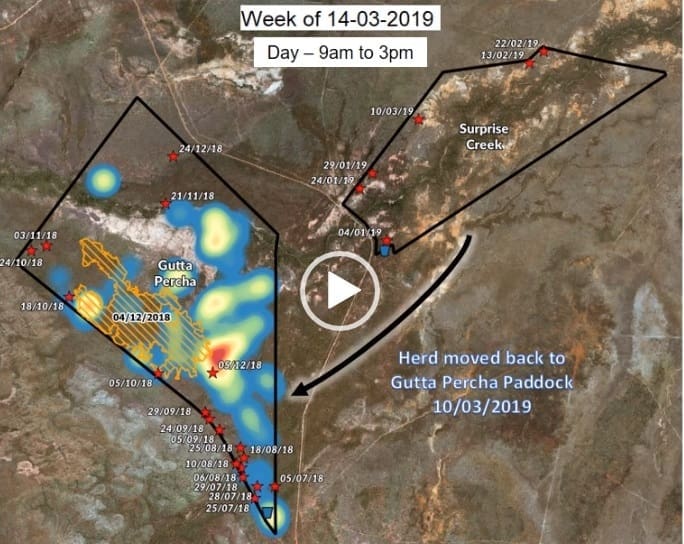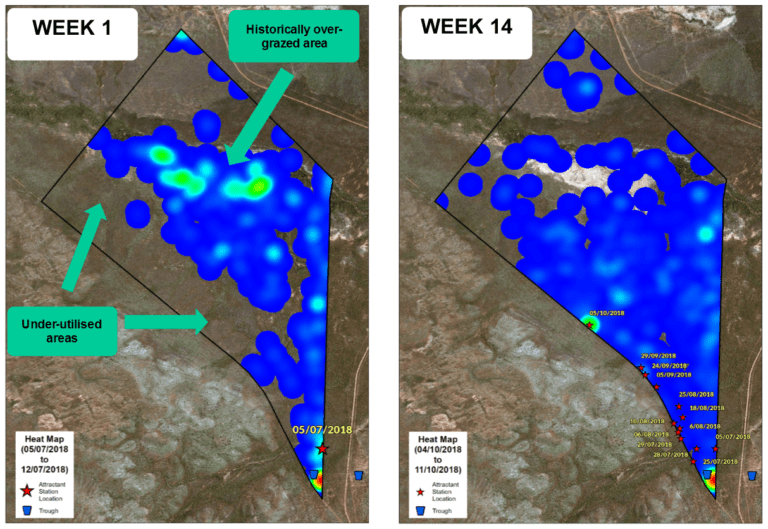IT IS well known that the grazing habits of cattle differ between night and day, but the Self Herding Project at the Victoria River Research Station at Kidman Springs in the Northern Territory has shed new light on what cattle get up to when they’re not being watched.
Through a compilation of hourly GPS trackable collar ‘pings’ over several months, an animation of grazing behaviour has been constructed (click the link below to access).
“Through the animation, we could really see the difference between the heifers’ utilisation of the paddock during the day versus the night,” said project leader and rangeland scientist, Dr Dionne Walsh.
“As expected, they spent a significant amount of time camped up near the watering point during the day, and moved out to graze late in the afternoon. During the hours of cooler temperature throughout the night, the heifers utilised many parts of the paddock, and certainly sought out the location of the attractant station (seen in the second video).”
“What we wouldn’t have been able to see with our own eyes, we have been able to capture using GPS collars —the rangeland self-herding technique certainly influences grazing behaviour,” Dr Walsh said.
The animated compilation of GPS pings also showed the strong effect that the first rains in November had on grazing distribution.
The area in the far north of the paddock was very under-utilised for the first few months of the trial, Dr Walsh said.
“This surprised us, because it is a black soil pasture with highly palatable species like curly bluegrass which we expected the heifers would find attractive. But then very suddenly, within a few days of the first decent rains of the wet season, they started using it, and returning there repeatedly over the subsequent weeks.”
When asked about the overall progression of the Self Herding project, Dr Walsh said it was on track to demonstrate that using a mobile attractant station can definitely influence grazing behaviour and can be used to direct grazing towards specific areas.
“We found that concentrating activity around an attractant station over a period of a few days helped to knock down old rank pasture, so we expect that these areas will grow higher quality feed and thus be more attractive after the next wet season.”
Click this link to access two videos: GPS collar pings of Self Herding Project heifers between 9am and 3pm; and GPS collar pings of Self Herding Project heifers between 3pm and 9am.

The Kidman Springs self-herding trial aims to test whether self-herding techniques can be used to create new grazing circuits within a paddock, thus creating a form of rotational grazing that does not rely on permanent fencing.
The trial uses feed attractants paired with signals to encourage cattle to make choices in response to positive behavioural and/or nutritional feedback.
A mobile ‘attractant station’ is used to achieve managed movements of cattle throughout the landscape. The attractant station comprises four small feed tubs paired with a visual cue (witches hats placed on a nearby road or firebreak) and an audible cue (a wind chime placed in a tree near the attractant station).
Each tub has a small amount of a supplementary feed added to it. Three of the tubs contain familiar feed items (urea, coarse salt and ‘Bruce’s Brew’, which is a mixture of locally-sourced wood ash and charcoal).
The fourth tub is reserved for the intermittent placement of highly attractive energy-rich ‘jackpots’ such as shipper pellets or molasses. The jackpots are paired with a unique sound cue, such as a whistle blown loudly at the time the jackpot is delivered. The intermittent use of jackpots keeps the cattle highly motivated to return to the attractant station on the off-chance that a particularly attractive food reward might be there.
The frequency and distance that the attractant station is moved around the paddock is very flexible. During busy times, the attractant station can be left for several days before being moved.

‘Heat maps’ generated by the hourly ping from the 10 heifers wearing GPS collars indicate the changed grazing behaviour between Week 1 and Week 14 of the trial. Grazing pressure has been reduced on the historically over-grazed area and becomes more evenly distributed across the under-utilised areas. Brighter colours indicate the greater frequency of visit in the area.
Many northern producers already move lick around their paddocks, but this method amplifies that approach by offering a variety of attractants and using intermittent and unpredictable timing. This has the effect of increasing interest for a broader range of animals in a mob.
Ten heifers in the trial are wearing satellite-monitored GPS collars that pinged at hourly intervals. The location data is used to generate day and night time maps showing how the animals are using the paddock over time in relation to the attractants and other factors like surface water and recently burnt areas.
For more information about the Self Herding Project, click here.


HAVE YOUR SAY